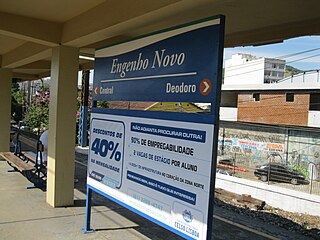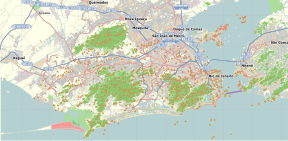
Central do Brasil is a major train station in the Brazilian city of Rio de Janeiro. It is the last stop of Rio's railway network, as well as a hub for connection with the city subway and a bus station. Central do Brasil was also a preeminent stop in the interstate Central do Brasil railroad, which linked Rio de Janeiro with São Paulo and Minas Gerais, though the railroad is now deactivated. The station is located in downtown Rio de Janeiro, along the Avenida Presidente Vargas and across from the Campo de Santana park. It was built in the Art Deco style.

The Rio de Janeiro Metro, commonly referred to as just the Metrô is a rapid transit network that serves the city of Rio de Janeiro, Brazil. The Metrô was inaugurated on 5 March 1979, and consisted of five stations operating on a single line. The system currently covers a total of 58 kilometres (36 mi), serving 41 stations, divided into three lines: Line 1 ; Line 2, which together travel over a shared stretch of line that covers 10 stations of an approximate distance of 5 kilometres (3.1 mi); and Line 4. Metrô Rio has the second highest passenger volume of the metro systems in Brazil, after the São Paulo Metro.

The Estrada de Ferro Central do Brasil was one of the principal railways of Brazil, uniting the states of Rio de Janeiro, São Paulo and Minas Gerais.

SuperVia Trens Urbanos is a rapid transit and commuter rail company operator, founded in Rio de Janeiro (Brazil) in November 1998. It carries around 750,000 passengers a day on a railroad network comprising 104 stations in 12 cities: Rio de Janeiro, Duque de Caxias, Guapimirim, Nova Iguaçu, Nilópolis, Mesquita, Queimados, São João de Meriti, Belford Roxo, Japeri, Paracambi and Magé.

Teodoro Fernandes Sampaio was an Afro-Brazilian polymath and public intellectual who worked as an engineer, geographer, politician, and historian.

Engenho Novo is a neighborhood of middle class and lower middle of the North Zone of Rio de Janeiro, Brazil.

São Cristóvão Station is a railway station in São Cristóvão, Rio de Janeiro which is serviced by the Rio de Janeiro Metro and SuperVia.

Events in the year 1960 in Brazil.

The Imperial Brazilian Army was the name given to the land force of the Empire of Brazil. The Brazilian Army was formed after the independence of the country from Portugal in 1822 and reformed in 1889, after the republican coup d'état that created the First Brazilian Republic, a dictatorship headed by the army.
Igor Rabello da Costa, known as Igor Rabello, is a Brazilian footballer who plays for Atlético Mineiro as a central defender.

Mangueira is a railway station in Mangueira, Rio de Janeiro which is serviced by the Supervia.

Praça da Bandeira Station, previously known as Lauro Müller Station, is a railway station in Praça da Bandeira, Rio de Janeiro which is serviced by the Supervia.

São Francisco Xavier is a railway station in São Francisco Xavier, Rio de Janeiro which is serviced by the Supervia.

Riachuelo, originally known as Riachuelo do Rio, is a railway station in Riachuelo, Rio de Janeiro which is serviced by the Supervia.

Engenho Novo is a railway station in Engenho Novo, Rio de Janeiro which is serviced by the Supervia.

Méier is a railway station in Méier, Rio de Janeiro which is serviced by the Supervia.
The Deodoro Line is a commuter rail line operated by SuperVia as part of the Rio de Janeiro Metropolitan Trains system. It runs from Deodoro, in the West Zone of Rio de Janeiro, through the North Zone to Central do Brasil Station, in Rio de Janeiro Downtown. The route and stations are shared with the Santa Cruz and Japeri Lines. It's the busiest line in the system. Since June 2020, it has been interconnected with the Santa Cruz Line.
The Japeri Line is a commuter rail line operated by SuperVia.
The 2021 Copa do Brasil final rounds were the final rounds of the 2021 Copa do Brasil football competition. They were played from 27 July to 15 December 2021. A total of 16 teams competed in the final rounds to decide the champions of the 2021 Copa do Brasil.
The 2022 Copa do Brasil final rounds were the final rounds of the 2022 Copa do Brasil football competition. They were played from 22 June to 19 October 2022. A total of 16 teams competed in the final rounds to decide the champions of the 2022 Copa do Brasil.
















